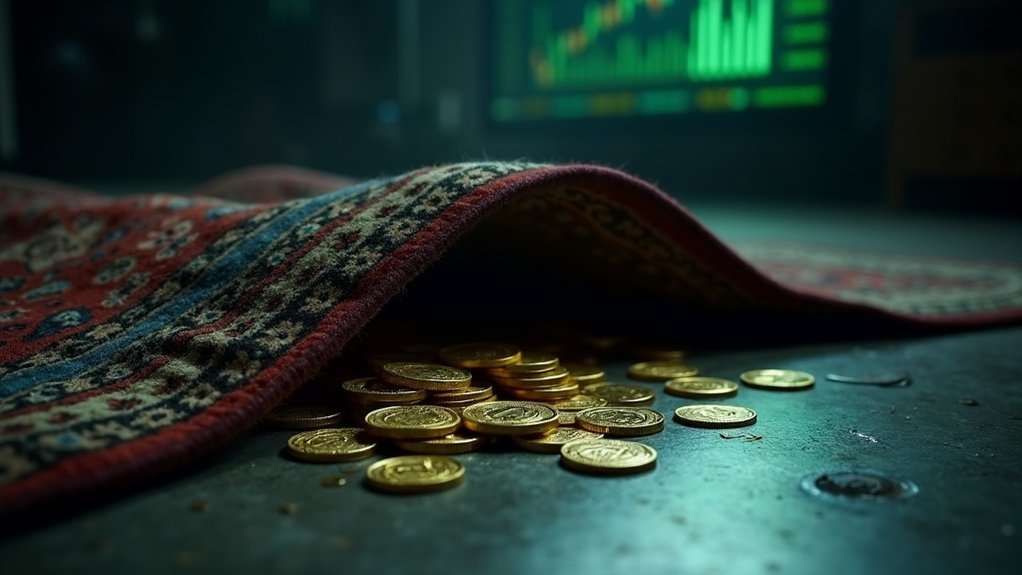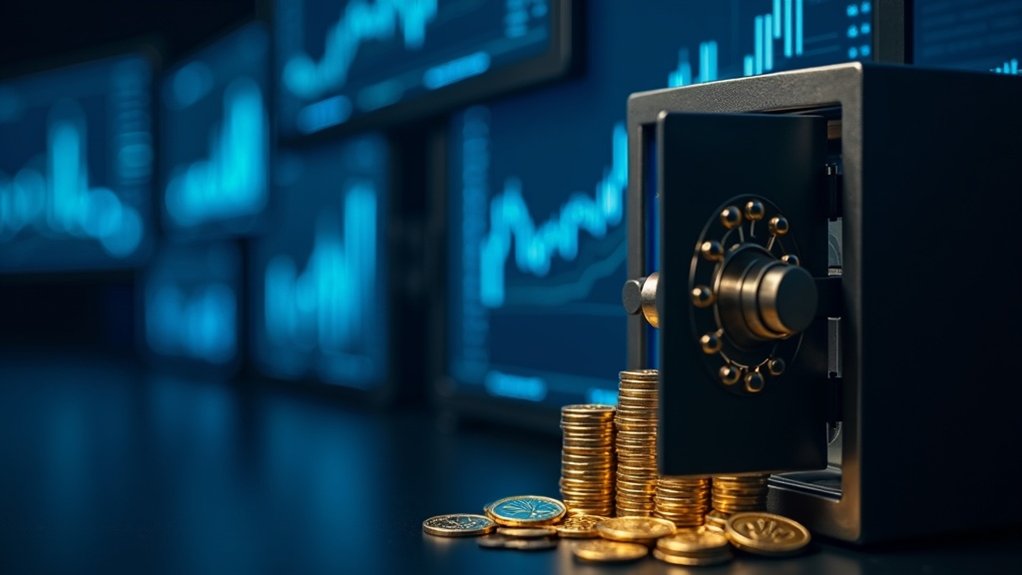Crypto rug pulls are scams where developers create tokens, drum up hype, then vanish with investors’ money. Pretty simple, really. They come in different flavors: hard pulls with malicious code, soft pulls relying on pure hype, or liquidity drains. Red flags include anonymous teams, promises of ridiculous returns, and no actual product. Over 300,000 tokens have scammed 2 million investors globally. The aftermath? Worthless tokens and empty wallets. The patterns become painfully obvious once you know what to look for.
While investors dream of striking it rich in cryptocurrency, predators lurk in the unregulated waters of the digital asset space. Rug pulls have become a notorious scam where developers create tokens, build hype, then vanish with investors’ money. The name itself tells the story—one minute you’re standing proud with your new investment, the next you’re flat on your back wondering what happened.
These scams follow a predictable pattern. New token appears. Price skyrockets 50X in a day. FOMO kicks in. You buy. Developers disappear. Your money? Gone. Your tokens? Worthless. It’s a tale as old as crypto itself, playing out on decentralized exchanges where listing requirements are basically nonexistent. These deceptive schemes are particularly rampant in decentralized finance projects. Legitimate airdrops require users to have compatible wallets before participating in token distributions.
The crypto hamster wheel spins again: buy the hype, fund the scam, hold the bag, repeat the pain.
The mechanics are deceptively simple. Scammers blast social media with promises of the “next Bitcoin,” recruit influencers to shill their token, and create flashy websites with roadmaps to nowhere. They’re selling a dream, not a product. And people buy it. Every. Single. Time.
Rug pulls come in flavors. Hard rug pulls involve malicious code that blocks selling or allows unlimited token minting. Soft rug pulls rely on hype alone—no coding tricks, just good old-fashioned abandonment after pumping the price. Liquidity pulls drain the trading pools. One protective measure is to look for projects with security audit checks conducted by reputable third parties. Pick your poison.
The numbers are staggering. Over 300,000 scam tokens have robbed approximately 2 million investors worldwide. That’s more victims than FTX, Celsius, and Voyager combined. Remember the Squid Game token? $3 million gone in minutes.
Red flags aren’t subtle. Anonymous developers? Check. Promises of 100X returns? Check. No actual product? Check. Yet investors still pile in, hoping they’ll be quick enough to grab profits before the inevitable collapse.
The aftermath is predictable. Worthless tokens. No recourse. Just empty wallets and valuable lessons. The crypto Wild West claims another batch of hopefuls who confused gambling with investing. Same story, different token. Rinse and repeat.
Frequently Asked Questions
How Can Investors Verify a Crypto Project’s Legitimacy Before Investing?
Investors should examine team transparency, seeking verifiable identities and proven track records. No anonymous devs, period.
Code matters—public repositories and third-party audits are non-negotiable.
Community vibes tell a story; watch for bot-like behavior or excessive hype.
Smart investors scrutinize tokenomics, especially distribution patterns and liquidity locks.
Red flags include unrealistic promises and restricted selling mechanisms.
The crypto space is littered with empty promises.
Due diligence isn’t optional—it’s survival.
Are There Legal Consequences for Developers Who Execute Rug Pulls?
Yes, legal consequences exist, but they’re tricky to enforce.
Rug pulls can fall under securities fraud, wire fraud, or theft laws depending on the jurisdiction. Problem is, crypto developers often hide behind pseudonyms.
Some high-profile cases have led to arrests and prosecutions—like the Squid Game token scammers in South Korea. U.S. authorities have brought charges too.
But let’s be real—with anonymous developers and cross-border operations, many perpetrators simply disappear with the funds.
Can Stolen Funds Be Recovered After a Rug Pull?
Recovering funds after a rug pull? Tough luck, usually.
Blockchain transactions are irreversible by design. Sometimes funds can be traced through the public ledger, but actually getting money back is rare.
Centralized exchanges might freeze assets if they catch suspicious activity fast enough.
Legal remedies exist in theory, but jurisdictional nightmares and anonymous scammers make enforcement nearly impossible.
Recovery firms offer services, but success rates are dismal.
The harsh reality: prevention beats recovery every time.
Which Cryptocurrencies Are Most Vulnerable to Rug Pulls?
Newer, hype-driven tokens on Binance Smart Chain are rug pull magnets. They account for 71% of all scams – yikes.
Ethereum follows at 19%. Projects with unaudited smart contracts (75% of cases) and anonymous teams? Red flags everywhere.
Cryptocurrencies claiming “real-world utility” or “metaverse integration” (31% of rug pulls in 2025) are especially risky.
Celebrity-backed coins with weak fundamentals? Classic setup.
Outdated codebases and poor access controls basically scream “take my money.”
What Tools or Platforms Help Detect Potential Rug Pulls?
Several tools now detect potential rug pulls.
Token Sniffer and Dextools examine smart contracts for suspicious admin functions or sell restrictions.
UNCX checks if liquidity is locked—crucial for avoiding scams. AI-powered platforms use pattern recognition to spot transaction anomalies, while SolidityScan’s QuickScan monitors for exploitable permissions.
Machine learning algorithms analyze social media sentiment too.
These platforms aren’t perfect, but they’re getting better at catching the bad guys before they vanish with your money.









